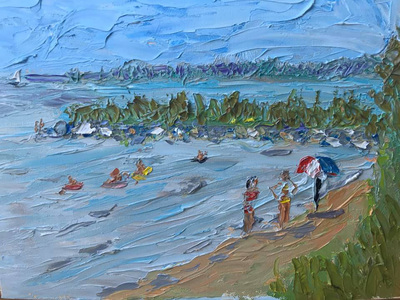Fine Art Prints

The end result of any artist's effort is a combination of many factors. What did they choose to paint? Why did they choose that subject? How did they see the subject? In the end, in addition to the tools used and the skill set supporting the artist, these questions are posed in the final piece.
One afternoon in the summer of 19, I was out on a mission to find a water scene that would speak to the joy we find relaxing by the water. I live in the DC suburbs, so I have lots of choices. The ocean is but 3 or so hours away. Between me and the Atlantic, there is the Chesapeake Bay and dozens of rivers and streams, as well as the National Harbor and the Baltimore Harbor. Obviously it is best to have a planned destination.
I make my choices based on time allowed and how much gas I have in the tank. Proof that we artists are not completely air-headed. On the morning in question, I wanted the smell and sound of the beach to surround me while I worked. A completed painting should be visually appeasing. It is more likely to be so if the artist is influenced by the environment where he or she is working. For the most part, we use all of our senses when creating. I know I do.
Back to the story. I headed over towards a point where the Chesapeake Bay meets the Patapsco River and Rock Creek area outside Baltimore, Md. I chose Fort Smallwood Park. I wouldn't consider it a hidden gem. It is just a spot that most folks haven't visited. Parked my car and took a stroll to see if anything struck my fancy. While it is true that you can paint anything, I wanted to paint something that would share the ambiance. After about 45 minutes of walking the grounds, I was about to move on to some other area. Then I heard the laughter of children and the sound of water splashing. I followed the sound down a tiny gravel road and came upon a secluded beach area.
This is it. I went back, got my car, drove down to the area, parked and unloaded my gear.
My initial step is usually to do a thumbnail sketch to make sure my composition is visually pleasing. I use a pencil and paper and put down what strikes me. I put some in and leave some out. While doing this sketch, my brain is conjuring up palette choices and styles. Every scene speaks to an artist and every artist sees a scene in their own fashion. When the sketch is complete, the fun begins.
I felt a palette knife was all I wanted to use in the painting. I wanted texture that would translate into an outdoorsy feeling. I wanted the waves to roll. Distant trees would only accent the cove where I was painting. I spent about two hours on the sketch and final painting.